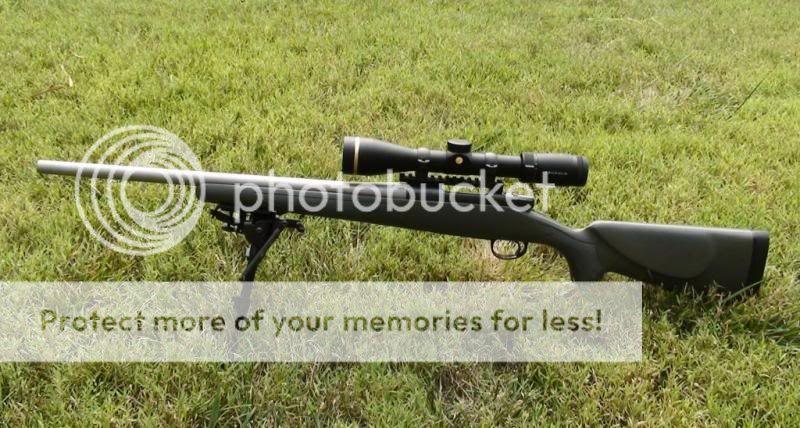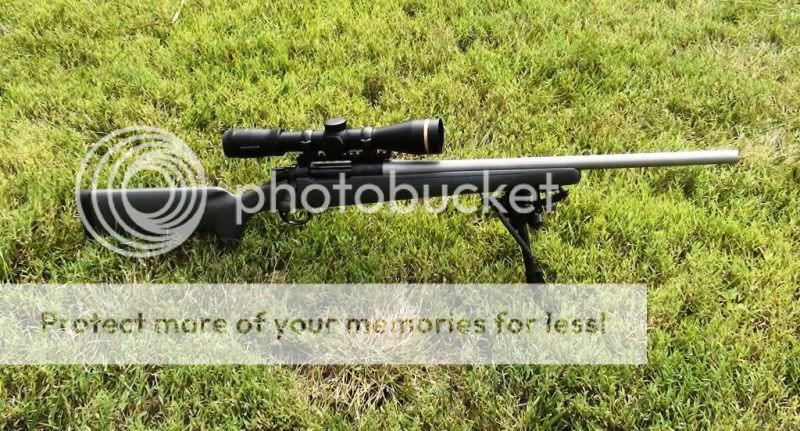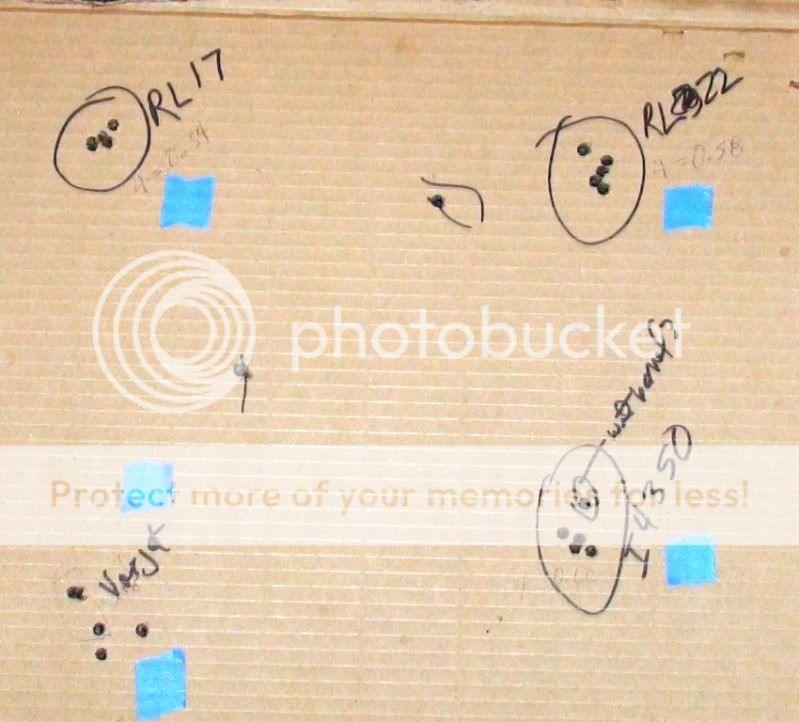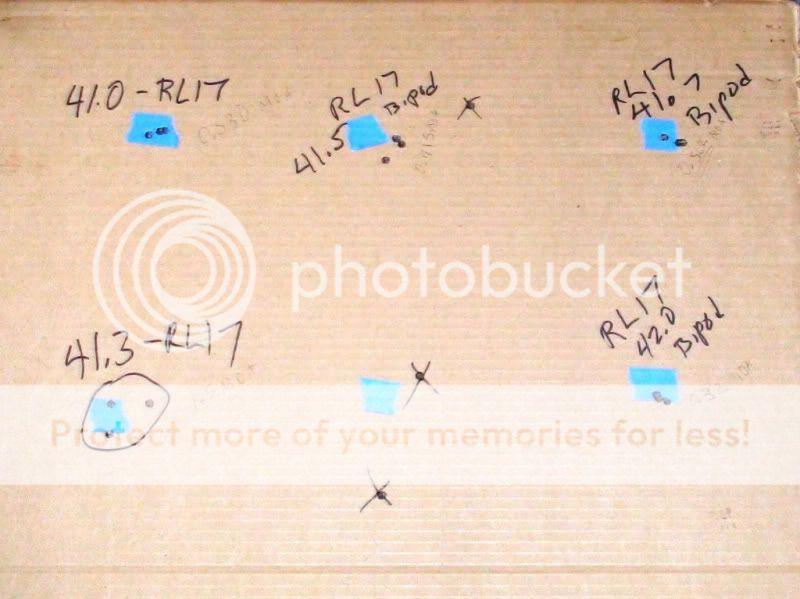Buffalobob
Well-Known Member
I go down to South Carolina pig hunting twice a year but usually don't kill anything myself. I decided that this was not a reflection on my hunting skill but most likely just a deficiency in my gun cabinet and that could easily be remedied, So off I went to see Eddie Harren who is a local gunsmith in Maryland and a champion bench rest shooter. Of nominal historical interest is back some 40+ years ago when I came off the DMZ with the 196 Lt Inf Bde we went to Quang Tri province and relieved the Marines who then went on home as part of the draw down in the closing days of RVN. Eddie with the Marines in Quang Tri. It pleases me greatly to actually know someone who walked the same trails in the Queson Mtns as I did and to have a rifle built by him.
So what I wanted was a short quick handling rifle for hunting pigs in the cypress swamps and pine thickets of South Carolina. The caliber had to be powerful enough to stop a large hog but have a reasonable amount of recoil so that the light weight of the rifle would not combine to be a miserable shooting experience. From shooting F-class competition I had seen several people shooting a 260 Remington with very good results so I reasoned that with the new Lapua high quality brass and some high sectional density bullets I could get good expansion and penetration without dislocating my shoulder from the recoil. What I had to start with was a Remington Model 7 action (short action). As fortune would have it Eddie had a MacMillian lightweight stock for a short action that he had bought for himself but never made into a rifle. He also had a great reamer in 260 Rem that he had used to build his own antelope hunting rifle. So all we needed was a barrel and Eddie and I decided that getting a barrel in a reasonable time was important and this eliminated quite a few makers. In the end Eddie ordered a Schneider 5P in a 8 twist and #2 contour and finished it at 20 inches. The 8 twist will easily stabilize 140 grain VLD bullet for not only deep penetration but also the rifle can see double duty as a light mountain rifle for long range work. Finished weight was six pounds eight ounces and with base, rings and scope it wound up at 7 pounds fourteen ounces. This is a very nice light weight. Eddie set the Remington trigger at about 2# which is great for me.
For optics I used an EGW 20 MOA cant base and a Leopold VR-6 scope with a variable range of 2X to 12X and a 42 mm objective. The 2X setting will be great for the cypress swamps and 12X will allow for about as much long range work as the 20 inch barrel will allow. It has both a CDS knob and a Boone and Crocket reticle which I may or may not ever use. The 30mm tube provides for a lot of elevation adjustment when matched with the canted rail. The scope is lightweight and a good match for a lightweight rifle.


So the first two jobs were to break in the barrel and find the top of the pressure curve for the chamber. I had four good powders for the 260 so I loaded up a series of five rounds with IMR 4350, Varget, RL17 and RL 22 (I wish I had a bottle of RL19) and some Berger 140 grain hybrids. For each powder, each round had a 0.5 grains more powder than the preceding one up to what I thought might be a max load the chamber will tolerate. This would allow me to find max pressure and velocity. I also had the bullets seated to jam so I could later back off the lands if I needed to.
During barrel break in, the rifle was cleaned frequently and it affected how the bullets flew being as I did not completely dry the barrel before firing. If you look at the picture you will see that Varget is a good example of the barrel being cleaned midway through the string and how it opens up the group. In the other three powders, the first shot is always out of group due to cleaning. Even with the difference in powder charge, I thought RL17 was least sensitive to powder charge and I did not believe I reached max pressure with the loads.

After the trip to the range, I cleaned the barrel again, disassembled the base and rings and put the optics back together using loctite being as everything seemed to be OK. I began load development with RL 17 and the 140 Berger Hybrids. Back to the range I went and first I was shooting off a pedestal rest but decided to cut to the chase and use a bipod. At 42 grains of RL 17, I had not gotten any extractor marks on the brass or stiff bolt lift, etc; but groups size had dropped down to 0.32 MOA which is my general level of skill-i.e. I am not able to shoot a rifle much better than that even if the rifle is more accurate.
I am very satisfied that a rifle that shoots 0.32 MOA from a bipod is accurate enough to kill a pig at 30 yards. Eddie did a good job building the rifle and I did not have a long wait.
I would just note that shooting a sub- eight pound rifle accurately is a hell of a lot more difficult than the 14-18 pound rifles I normally shoot.

So what I wanted was a short quick handling rifle for hunting pigs in the cypress swamps and pine thickets of South Carolina. The caliber had to be powerful enough to stop a large hog but have a reasonable amount of recoil so that the light weight of the rifle would not combine to be a miserable shooting experience. From shooting F-class competition I had seen several people shooting a 260 Remington with very good results so I reasoned that with the new Lapua high quality brass and some high sectional density bullets I could get good expansion and penetration without dislocating my shoulder from the recoil. What I had to start with was a Remington Model 7 action (short action). As fortune would have it Eddie had a MacMillian lightweight stock for a short action that he had bought for himself but never made into a rifle. He also had a great reamer in 260 Rem that he had used to build his own antelope hunting rifle. So all we needed was a barrel and Eddie and I decided that getting a barrel in a reasonable time was important and this eliminated quite a few makers. In the end Eddie ordered a Schneider 5P in a 8 twist and #2 contour and finished it at 20 inches. The 8 twist will easily stabilize 140 grain VLD bullet for not only deep penetration but also the rifle can see double duty as a light mountain rifle for long range work. Finished weight was six pounds eight ounces and with base, rings and scope it wound up at 7 pounds fourteen ounces. This is a very nice light weight. Eddie set the Remington trigger at about 2# which is great for me.
For optics I used an EGW 20 MOA cant base and a Leopold VR-6 scope with a variable range of 2X to 12X and a 42 mm objective. The 2X setting will be great for the cypress swamps and 12X will allow for about as much long range work as the 20 inch barrel will allow. It has both a CDS knob and a Boone and Crocket reticle which I may or may not ever use. The 30mm tube provides for a lot of elevation adjustment when matched with the canted rail. The scope is lightweight and a good match for a lightweight rifle.


So the first two jobs were to break in the barrel and find the top of the pressure curve for the chamber. I had four good powders for the 260 so I loaded up a series of five rounds with IMR 4350, Varget, RL17 and RL 22 (I wish I had a bottle of RL19) and some Berger 140 grain hybrids. For each powder, each round had a 0.5 grains more powder than the preceding one up to what I thought might be a max load the chamber will tolerate. This would allow me to find max pressure and velocity. I also had the bullets seated to jam so I could later back off the lands if I needed to.
During barrel break in, the rifle was cleaned frequently and it affected how the bullets flew being as I did not completely dry the barrel before firing. If you look at the picture you will see that Varget is a good example of the barrel being cleaned midway through the string and how it opens up the group. In the other three powders, the first shot is always out of group due to cleaning. Even with the difference in powder charge, I thought RL17 was least sensitive to powder charge and I did not believe I reached max pressure with the loads.

After the trip to the range, I cleaned the barrel again, disassembled the base and rings and put the optics back together using loctite being as everything seemed to be OK. I began load development with RL 17 and the 140 Berger Hybrids. Back to the range I went and first I was shooting off a pedestal rest but decided to cut to the chase and use a bipod. At 42 grains of RL 17, I had not gotten any extractor marks on the brass or stiff bolt lift, etc; but groups size had dropped down to 0.32 MOA which is my general level of skill-i.e. I am not able to shoot a rifle much better than that even if the rifle is more accurate.
I am very satisfied that a rifle that shoots 0.32 MOA from a bipod is accurate enough to kill a pig at 30 yards. Eddie did a good job building the rifle and I did not have a long wait.
I would just note that shooting a sub- eight pound rifle accurately is a hell of a lot more difficult than the 14-18 pound rifles I normally shoot.

